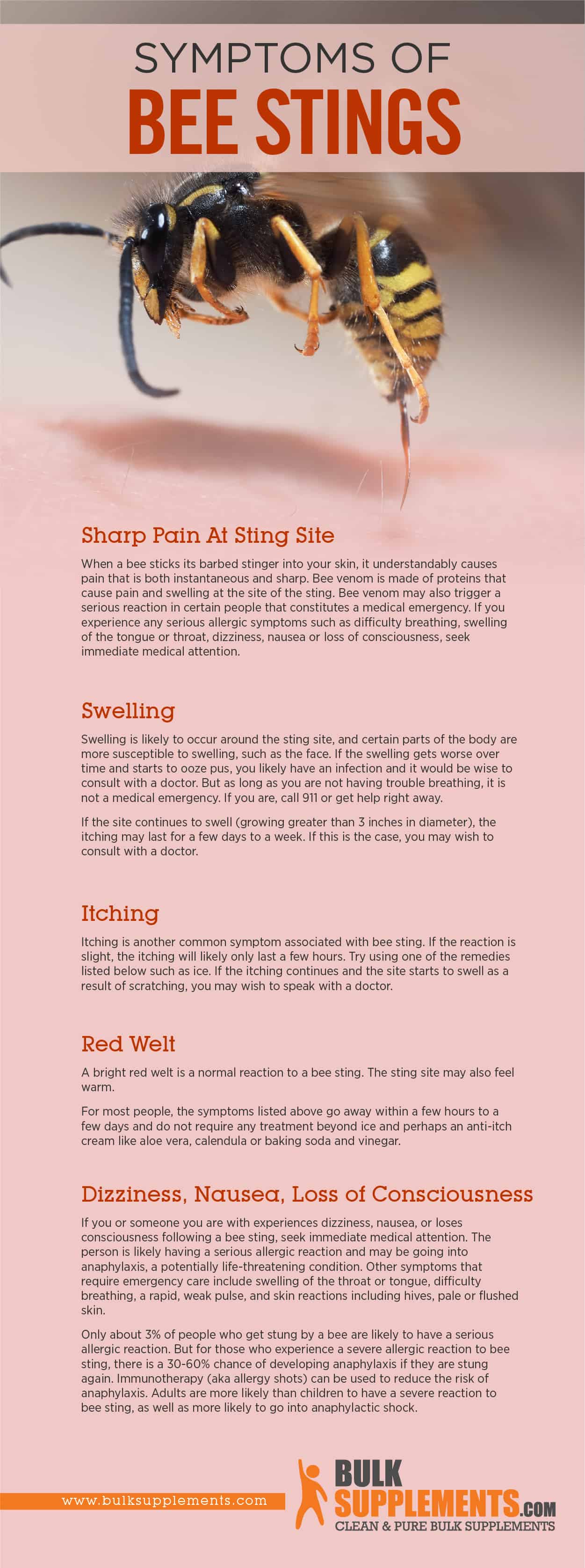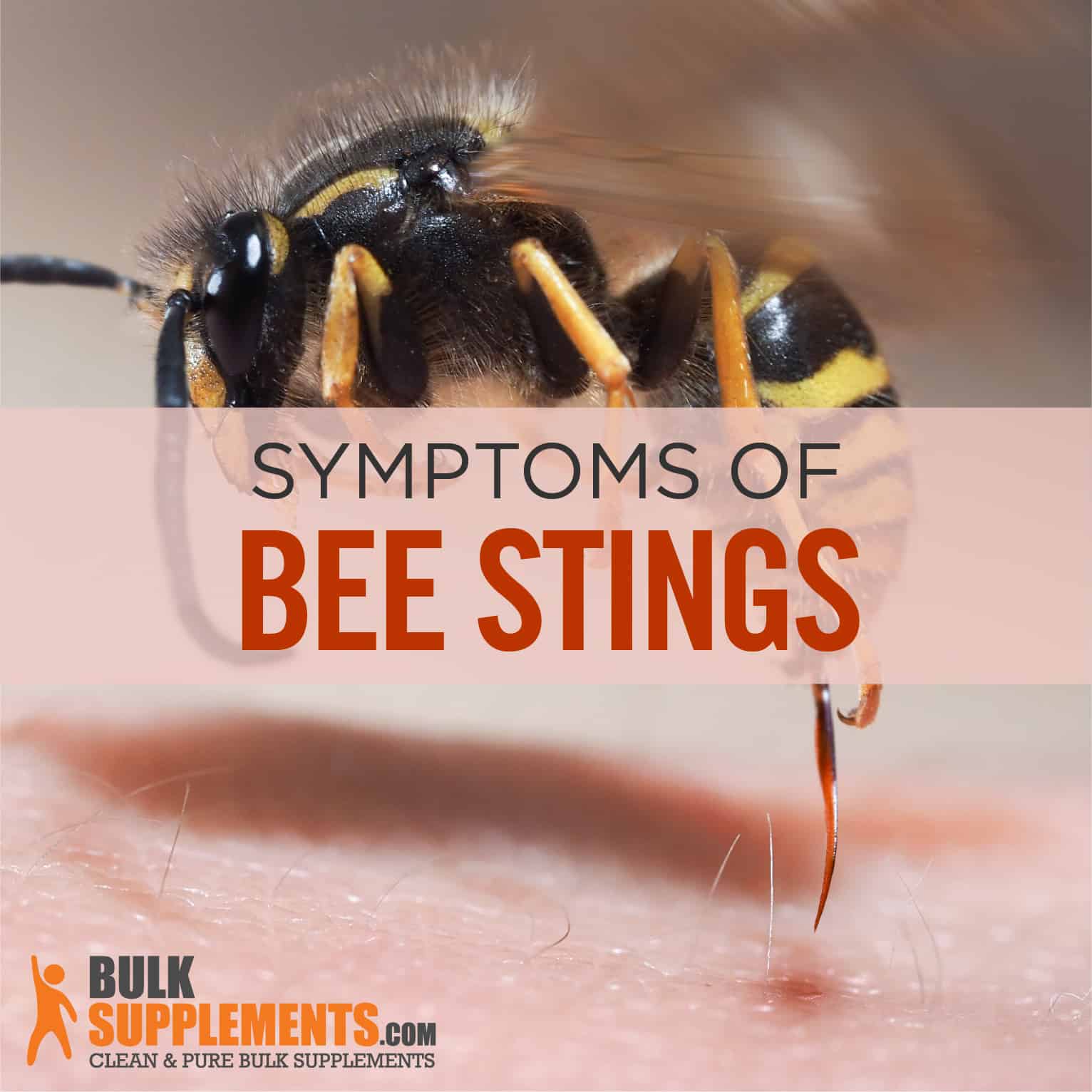What is a Bee Sting?
Bee stings are painful, but are simply a minor annoyance for most people and can easily be treated at home. However, if you get stung multiple times or if you are allergic to bee venom, you may require emergency care.
Warm weather brings everyone outside, including bees. Of course, we need bees to pollinate, but no one likes getting stung by one. When stung, bees release a toxin that can cause an allergic reaction. Symptoms of a mild allergic reaction might be redness, swelling and pain at the site of the sting. Symptoms of a severe allergic reaction to bee stings could include hives, swelling in the throat and/or tongue, rapid pulse, difficulty breathing, wheezing or dizziness. Other signs of a severe allergic reaction include nausea, vomiting and diarrhea. Loss of consciousness is also possible. If you experience any of the severe symptoms, it is important to get medical attention immediately to avoid a potentially life-threatening reaction called anaphylaxis.
In the case of multiple stings, the cumulative effect of the bee venom can make you very sick. Signs of toxicity include dizziness, headache, vertigo, fever, nausea, vomiting, diarrhea, and convulsions (x). For children, seniors and those with breathing or heart problems, multiple stings may constitute a medical emergency.
There are several natural remedies you can use at home to alleviate the pain of a bee sting. Ice is usually readily available and does a fine job of numbing the site while also reducing swelling. Aloe vera is another excellent, natural skin soother you can use as often as needed. Bee stings are acidic and so an alkaline paste made from apple cider vinegar and baking soda works fast to neutralize the sting. White toothpaste is another classic remedy.
Causes of Bee Stings
When a bee stings you, the barbed stinger penetrates your skin, releasing a toxin that causes pain as well as other symptoms.
If you do find a stinger, you want to remove it quickly to reduce the amount of venom that will be released into your system and also to prevent infection. Washing the area may do the trick, but tweezers might also be required. If tweezers aren’t available, you can use the edge of a credit card or other hard surface to remove it.
It is important to remember that bees usually only sting as a defensive action. If you leave them alone, they will usually do the same. But if you do mistakenly disturb a bee or hive, move away from it calmly but quickly.
Of course, bees are not the only insects that sting. Wasps and hornets sting as well. People who are allergic to wasp venom are also allergic to hornet stings.
Even if you are not allergic to a bee sting, you still want to treat it right away. Stings are often quite painful and the faster you act, the sooner you will feel relief. Identifying a bee sting is usually straightforward because honeybees leave behind their barb in your skin. This also causes the honeybee to die. However, other types of bees such as African bees do not lose their stinger and can sting more than once. So if you aren’t sure what stung you, look for a stinger. The barb is small, which can make it hard to see, but it will look like a black dot at the center of the sting site. If you don’t see a stinger, another insect may be the culprit (x).
Bee Sting Symptoms
Sharp Pain At Sting Site
When a bee sticks its barbed stinger into your skin, it understandably causes pain that is both instantaneous and sharp. Bee venom is made of proteins that cause pain and swelling at the site of the sting (x). Bee venom may also trigger a serious reaction in certain people that constitutes a medical emergency. If you experience any serious allergic symptoms such as difficulty breathing, swelling of the tongue or throat, dizziness, nausea or loss of consciousness, seek immediate medical attention.
Swelling
Swelling is likely to occur around the sting site, and certain parts of the body are more susceptible to swelling, such as the face. If the swelling gets worse over time and starts to ooze pus, you likely have an infection and it would be wise to consult with a doctor. But as long as you are not having trouble breathing, it is not a medical emergency. If you are, call 911 or get help right away.
If the site continues to swell (growing greater than 3 inches in diameter), the itching may last for a few days to a week. If this is the case, you may wish to consult with a doctor.
Itching
Itching is another common symptom associated with bee sting. If the reaction is slight, the itching will likely last only last a few hours. Try using one of the remedies listed below such as ice. If the itching continues and the site starts to swell as a result of scratching, you may wish to speak with a doctor.
Red Welt
A bright red welt is a normal reaction to a bee sting. The sting site may also feel warm.
For most people, the symptoms listed above go away within a few hours to a few days and do not require any treatment beyond ice and perhaps an anti-itch cream like aloe vera, calendula or baking soda and vinegar.
Dizziness, Nausea, Loss of Consciousness
If you or someone you are with experiences dizziness, nausea, or loses consciousness following a bee sting, seek immediate medical attention. The person is likely having a serious allergic reaction and may be going into anaphylaxis, a potentially life-threatening condition. Other symptoms that require emergency care include swelling of the throat or tongue, difficulty breathing, a rapid, weak pulse, and skin reactions including hives, pale or flushed skin.
Only about 3% of people who get stung by a bee are likely to have a serious allergic reaction. But for those who experience a severe allergic reaction to bee sting, there is a 30-60% chance of developing anaphylaxis if they are stung again. Immunotherapy (aka allergy shots) can be used to reduce the risk of anaphylaxis. Adults are more likely than children to have a severe reaction to bee sting, as well as more likely to go into anaphylactic shock.

Bee Sting Remedies and Supplements
There are many simple home remedies and natural supplements available for the pain associated with bee sting. After removing the stinger, wash the sting site with soap and water to clean the area and reduce the risk of infection. Once the area is clean and dry, you can try one or more of the following:
Aloe Vera
Aloe vera is well-known for soothing skin irritation and pain relief. Apply directly to affected area and repeat as needed (x).
Lavender, Tea Tree Oil and Witch Hazel
Lavender essential oil is an anti-inflammatory that can reduce swelling. After mixing with a carrier oil, apply a drop to the affected area. Tea tree oil is another essential oil that has antiseptic properties and can relieve pain. As with all essential oils, mix first with a carrier oil then apply a drop to sting site. Witch hazel has long been a tradition remedy for irritated skin including bee stings. It can reduce itching and pain, as well as inflammation. Apply directly to sting and repeat as needed (x, x, x).
Other Remedies
Ice is a simple, yet effective remedy for bee stings. Protect the skin with a towel or cloth and apply ice for no more than 20 minutes at a time. Not only will ice slow the release of toxins into your body, but it will also numb the pain and reduce the swelling.
Baking soda and apple cider vinegar is a traditional remedy and most people have the ingredients on hand. Bee venom is acidic, while baking soda and vinegar are alkaline, which produces a neutralizing effect. Mix the two into a paste and apply. The paste may sting momentarily, but it should quickly subside.
Toothpaste is another simple home remedy. The mint is cooling and the glycerin and baking soda neutralize the venom. Simply apply a dab and let it sit for a few minutes, then wash off. Effects may last for up to 5 hours, but reapply as needed.
Ironically, honey can alleviate pain and itchiness. The stickiness can be a little messy, but it may also help keep you from itching, lowering the risk of infection. Additionally, honey contains antiseptic properties, which also help to prevent infection.
Avoid Bees
Of course, it is always best to avoid getting stung in the first place. While most commercial insect repellents are loaded with chemicals, there are natural repellents and supplements you can use to deter bees and other stinging insects. Tea tree oil works great as a repellent. You can simply dab it on your clothing near openings such as on the wrists of your gloves, the collar of your shirt or the hem of your pants to protect exposed skin. You can even add it to your shampoo to help protect your head. It is important to always dilute with a carrier oil before application on the body. Do not use raw essential oils directly on the skin.
Bees sometimes make the mistake of coming indoors and being unable to escape, which may cause them to become agitated and more likely to sting. If you have a problem with bees inside the house, simply apply repellent around doorways, in closets and anywhere else you want to repel bees. Do not spray repellent near or on the face, particularly near the eyes, and take care not to spray near food.
The Bottom Line
While a bee sting can be serious if you are among the tiny percentage with an allergy to bee venom, for most people it is usually nothing more than a nuisance. A bee sting can generally be treated at home with simple remedies such as aloe vera, ice, honey or toothpaste.


